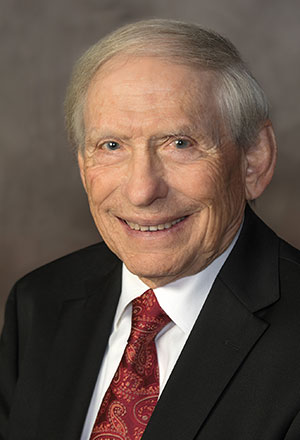Paul McEnroe
Owner/Operator, Rancho La Purisma
MSEE 1960
For foresight and drive that contributed to the pioneering development of the barcode, used as the international standard for product identification
In 1959 and 1960, as he was working toward a Purdue master’s degree in electrical engineering while at The Boeing Company as an associate engineer, Paul McEnroe discovered that what he was learning could enable him to make a difference.
“I came to realize that as an engineer I may have the opportunity of applying technology to make a contribution to society, which I came to recognize is the most important accomplishment we can achieve,” he says.
And achieve, he did. What he did next, while working as a lab director at IBM, has made a bigger difference worldwide than even he might have imagined as a student. The globally ubiquitous barcode that appears on almost all products worldwide, was created, developed and produced by McEnroe and a team he formed and managed at IBM.
During his 23 years at IBM, he developed many other technologies, including the retail industry’s magnetic code and stripe, and the barcode’s scanners. The scanners, both handheld — on which he holds the patent — and fixed, or built into the check stand, became the world’s first high-volume commercial laser products. He also developed the Token Ring local area network technology, known as the IEEE 802.5 International Standard, as well as IBM’s first user custom chip, its first “intelligent” terminal and first distributed system.
As IBM’s group director of systems development, McEnroe managed about 500 engineers and scientists for the company’s Data Processing Product Group, which was responsible for about 90 percent of IBM’s products worldwide. He also directed 2,500 engineers at the IBM lab in Research Triangle Park of Raleigh, North Carolina, where he was responsible for the development and business management of almost all of IBM’s communications products.
After 24 years with IBM, he became president of Trilogy, a wafer-scale technology- based mainframe computer company that was the largest startup of its kind at the time. At Trilogy, which merged with Digital Equipment Corporation, he developed copper-polyimide multichip module technology.
After decades as a leader in his professional field, he now is a rancher — the owner/operator of Rancho La Purisima in Santa Ynez Valley, California. He remembers fondly his time at Purdue.
McEnroe is especially laudatory of his advanced calculus professor, John Dyer-Bennet. “Rigor in his class required advanced thinking in English and logic,” McEnroe says. “It was not easy, but every lecture was an art form disguised as calculus. Only after his class did I begin to understand what math really was.”
Another favorite professor was William Hayt, a former head of the School of Electrical Engineering. McEnroe remembers that Hayt recommended the textbook “Classic Electricity and Magnetism,” which, to McEnroe’s dismay, was available at the bookstore only in German.
Hayt said, “‘That’s OK, you will be able to figure it out; it’s mostly equations anyway,’” McEnroe recalls. “With only six students, none of whom spoke German, it was, nevertheless, a great class. Somehow, I later acquired an English translation of the book, which remains in the library in my living room 57 years later. It still has a $5.50 price tag.”
Whatever task you undertake, do the very best that you can do.”Paul McEnroe
Career Highlights
| 1994-present | Owner/Operator, Rancho La Purisima |
|---|---|
| 1992-1994 | President, The Pathway Group consulting |
| 1987-1992 | Director, Advanced Engineering and Manufacturing, Digital Equipment Corporation |
| 1984-1987 | President, Trilogy Systems Corporation |
| 1960-1984 | Lab Director, IBM |
| 1959-1959 | Associate Engineer, Bomarc Missile System, The Boeing Company |
Education
| 1959 | BS Electrical Engineering, University of Dayton |
|---|---|
| 1960 | MS Electrical Engineering, Purdue University |
| 1972 | MS Engineering, Stanford University |

